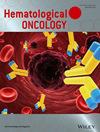Efferocytosis and M2 Macrophage Polarization Gene Expression Correlates With Relapsed and Refractory Classical Hodgkin Lymphoma Patients: A Multi-Omic Analysis
Abstract
Classical Hodgkin Lymphoma (cHL) exhibits rare malignant Hodgkin-Reed Sternberg (HRS) cells within a reactive immune microenvironment. This study developed an HRS cell gene expression signature to identify HRS cells in single-cell RNA sequencing (scRNA-seq) data, investigated cognate interactions, analyzed bulk transcriptomes, and assessed predictors of treatment failure. Differentially expressed genes (DEGs) from RelB-silenced U-HO1 cells were identified, and scRNA-seq data was processed to annotate cell types. Cognate interactions were analyzed using CellPhoneDB, and bulk transcriptome deconvolution was performed using CIBERSORT. Ridge regression models were built and evaluated. A 37-gene HRS cell signature identified HRS cells (2.7%) in scRNA-seq data, revealing efferocytosis pathway enrichment. Macrophages showed the highest cognate interactions, including efferocytosis-related interactions with HRS cells. Bulk transcriptome analysis of 130 cHL patients showed increased M2 macrophage proportions correlated with poorer treatment response (p < 0.001). Ridge regression predicted response to treatment (RtoT) with an AUC of 0.83, identifying HRS cells and M2 macrophages as key predictors. Hierarchical clustering based on 19 genes revealed distinct RtoT outcomes, with high efferocytosis/M2 gene expression correlating with poor response. Increased MerTK, CD209, CD14, and CD36 expression was associated with poorer outcomes. Combining gene expression and cell type proportions improved RtoT prediction (AUC 0.87). A validated HRS cell gene expression signature enabled precise HRS cell identification and accurate estimation of cell proportions. HRS cell and M2 macrophage proportions, along with efferocytosis-related genes, predicted treatment failure. Efferocytosis-mediated M2 macrophage polarization, controlled by HRS cells, may be a critical immune checkpoint in cHL.

 求助内容:
求助内容: 应助结果提醒方式:
应助结果提醒方式:


